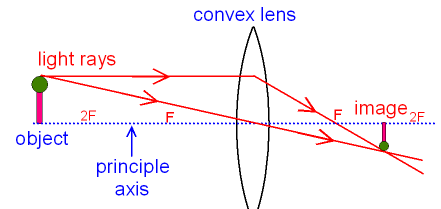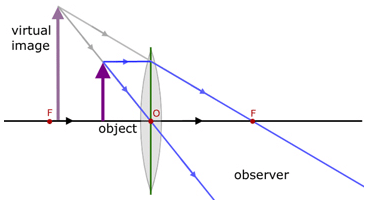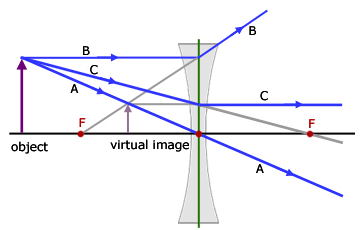Class 7 Exam > Class 7 Questions > Why convex lens used as a magnifying glass?
Start Learning for Free
Why convex lens used as a magnifying glass?
Verified Answer
Why convex lens used as a magnifying glass?
In your image it is not clear how you actually end up with a "big image". It is not enough to take into account just one light ray per point on the object.
You also need to consider how we actually see something, because if you think of it, at any moment there is light hitting our eye that comes from all kinds of directions and all kind of objects. However only a small part of it is actually used to make up the image we see.
You need to distinguish between virtual images and real images.
Real images are formed if all (or at least many) light rays coming from one point of the object are focused into one point on the viewer side. In that case you can for instance put a screen/paper on the viewer side on which an image gets projected. This is for instance the case in projectors or cameras.
In the case of Virtual images, the light rays diverge on the viewer side, so rays coming from one point of the object are not focused into a single point on the viewer side anywhere. Therefore one cannot have a projection directly onto a screen. However all the rays from one point of the object appear on the viewer side as if they are coming from a single point (if there was no lens). The eye re-focuses all these rays and produces a real image inside the eye, in the same way as it would do when looking at a real object the size/distance of the virtual image.
Let's look at the four combinations of virtual/real convex/concave lenses for a single lens:
Convex, real image
If the object is located outside the focal length of the lens, a real (reversed) image is formed on the viewer side. This is effectively what you have in case of cameras, though they have somewhat more complicated optical system, since for instance they need to keep the distance from the lens to the film/sensor/screen constant, independent on how far away the object is. If you take a magnifying glass and look at distant object through it you should also get this effect. But note, that in that case your eye is not where the image is formed but further away (to the right in the image below).

Convex, virtual image
If the object is within the focal length of the lens a virtual image is formed. Light rays on the observer side are diverging but appear to come from a point corresponding to a larger upright (virtual) object. This is the case for the magnifying glass when used to magnify things.
Concave, virtual image

Independent on whether the object is inside or outside the focal length, these lenses always produce a virtual image that is smaller than the original.

 This question is part of UPSC exam. View all Class 7 courses
This question is part of UPSC exam. View all Class 7 courses
Most Upvoted Answer
Why convex lens used as a magnifying glass?
Introduction
A convex lens, commonly known as a magnifying glass, is a simple optical instrument that enlarges the appearance of objects. This is achieved through its unique shape and the principles of light refraction.
How a Convex Lens Works
- Refraction of Light: When light rays pass through a convex lens, they bend towards the center due to the lens's curvature. This bending of light is known as refraction.
- Focal Point: A convex lens has a focal point where parallel light rays converge. When an object is placed closer to the lens than its focal length, the lens produces a virtual image that appears larger and upright.
Magnification Process
- Positioning the Object: To use a convex lens as a magnifying glass, the object should be positioned between the lens and its focal point.
- Virtual Image Formation: The lens forms a virtual image that is larger than the actual object. This image is seen through the lens and appears to be located behind the lens.
Benefits of Using a Convex Lens
- Enhanced Visibility: By magnifying objects, a convex lens allows for detailed observation of small features that are difficult to see with the naked eye.
- Ease of Use: Magnifying glasses are portable and simple to use, making them popular for various applications, including reading fine print, examining small objects, and hobbies like stamp collecting.
Conclusion
In summary, the convex lens functions as a magnifying glass by utilizing the principles of light refraction to produce a larger, upright virtual image of an object. Its effectiveness and ease of use make it an essential tool for enhancing our visual experience.
A convex lens, commonly known as a magnifying glass, is a simple optical instrument that enlarges the appearance of objects. This is achieved through its unique shape and the principles of light refraction.
How a Convex Lens Works
- Refraction of Light: When light rays pass through a convex lens, they bend towards the center due to the lens's curvature. This bending of light is known as refraction.
- Focal Point: A convex lens has a focal point where parallel light rays converge. When an object is placed closer to the lens than its focal length, the lens produces a virtual image that appears larger and upright.
Magnification Process
- Positioning the Object: To use a convex lens as a magnifying glass, the object should be positioned between the lens and its focal point.
- Virtual Image Formation: The lens forms a virtual image that is larger than the actual object. This image is seen through the lens and appears to be located behind the lens.
Benefits of Using a Convex Lens
- Enhanced Visibility: By magnifying objects, a convex lens allows for detailed observation of small features that are difficult to see with the naked eye.
- Ease of Use: Magnifying glasses are portable and simple to use, making them popular for various applications, including reading fine print, examining small objects, and hobbies like stamp collecting.
Conclusion
In summary, the convex lens functions as a magnifying glass by utilizing the principles of light refraction to produce a larger, upright virtual image of an object. Its effectiveness and ease of use make it an essential tool for enhancing our visual experience.
Attention Class 7 Students!
To make sure you are not studying endlessly, EduRev has designed Class 7 study material, with Structured Courses, Videos, & Test Series. Plus get personalized analysis, doubt solving and improvement plans to achieve a great score in Class 7.

|
Explore Courses for Class 7 exam
|

|
Similar Class 7 Doubts
Why convex lens used as a magnifying glass?
Question Description
Why convex lens used as a magnifying glass? for Class 7 2024 is part of Class 7 preparation. The Question and answers have been prepared according to the Class 7 exam syllabus. Information about Why convex lens used as a magnifying glass? covers all topics & solutions for Class 7 2024 Exam. Find important definitions, questions, meanings, examples, exercises and tests below for Why convex lens used as a magnifying glass?.
Why convex lens used as a magnifying glass? for Class 7 2024 is part of Class 7 preparation. The Question and answers have been prepared according to the Class 7 exam syllabus. Information about Why convex lens used as a magnifying glass? covers all topics & solutions for Class 7 2024 Exam. Find important definitions, questions, meanings, examples, exercises and tests below for Why convex lens used as a magnifying glass?.
Solutions for Why convex lens used as a magnifying glass? in English & in Hindi are available as part of our courses for Class 7.
Download more important topics, notes, lectures and mock test series for Class 7 Exam by signing up for free.
Here you can find the meaning of Why convex lens used as a magnifying glass? defined & explained in the simplest way possible. Besides giving the explanation of
Why convex lens used as a magnifying glass?, a detailed solution for Why convex lens used as a magnifying glass? has been provided alongside types of Why convex lens used as a magnifying glass? theory, EduRev gives you an
ample number of questions to practice Why convex lens used as a magnifying glass? tests, examples and also practice Class 7 tests.

|
Explore Courses for Class 7 exam
|

|
Suggested Free Tests
Signup for Free!
Signup to see your scores go up within 7 days! Learn & Practice with 1000+ FREE Notes, Videos & Tests.

























